
Government consulting firm Booz Allen Hamilton (NYSE:BAH) fell short of the market’s revenue expectations in Q1 CY2025, but sales rose 7.3% year on year to $2.97 billion. The company’s full-year revenue guidance of $12.25 billion at the midpoint came in 4.5% below analysts’ estimates. Its non-GAAP profit of $1.61 per share was in line with analysts’ consensus estimates.
Is now the time to buy Booz Allen Hamilton? Find out by accessing our full research report, it’s free.
Booz Allen Hamilton (BAH) Q1 CY2025 Highlights:
- Revenue: $2.97 billion vs analyst estimates of $3.03 billion (7.3% year-on-year growth, 1.8% miss)
- Adjusted EPS: $1.61 vs analyst estimates of $1.61 (in line)
- Adjusted EBITDA: $316 million vs analyst estimates of $331.6 million (10.6% margin, 4.7% miss)
- Management’s revenue guidance for the upcoming financial year 2026 is $12.25 billion at the midpoint, missing analyst estimates by 4.5% and implying 2.3% growth (vs 12.4% in FY2025)
- Adjusted EPS guidance for the upcoming financial year 2026 is $6.38 at the midpoint, missing analyst estimates by 7.4%
- EBITDA guidance for the upcoming financial year 2026 is $1.34 billion at the midpoint, below analyst estimates of $1.43 billion
- Operating Margin: 9.2%, in line with the same quarter last year
- Free Cash Flow Margin: 6.5%, up from 4.6% in the same quarter last year
- Organic Revenue rose 6.2% year on year (13.9% in the same quarter last year)
- Market Capitalization: $16.35 billion
Company Overview
With roots dating back to 1914 and deep ties to nearly all U.S. cabinet-level departments, Booz Allen Hamilton (NYSE:BAH) provides management consulting, technology services, and cybersecurity solutions primarily to U.S. government agencies and military branches.
Sales Growth
Examining a company’s long-term performance can provide clues about its quality. Any business can experience short-term success, but top-performing ones enjoy sustained growth for years.
With $11.98 billion in revenue over the past 12 months, Booz Allen Hamilton is one of the larger companies in the business services industry and benefits from a well-known brand that influences purchasing decisions.
As you can see below, Booz Allen Hamilton grew its sales at an impressive 9.9% compounded annual growth rate over the last five years. This is a great starting point for our analysis because it shows Booz Allen Hamilton’s demand was higher than many business services companies.
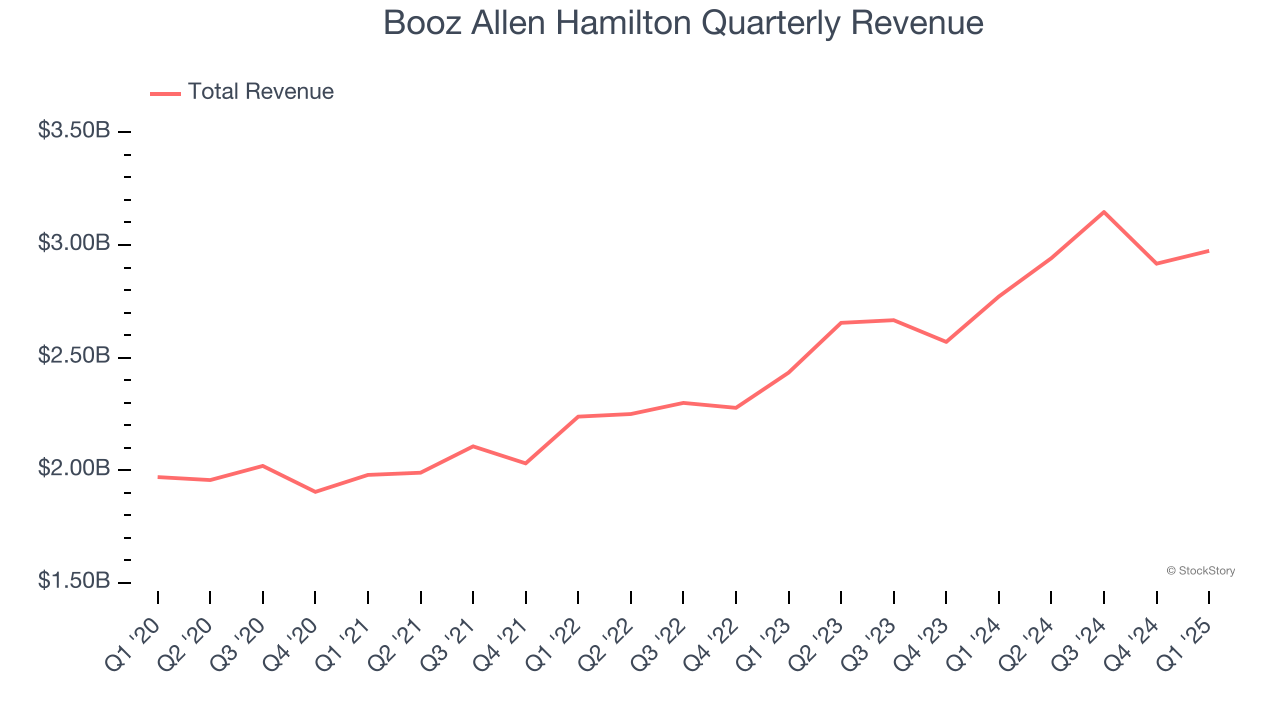
Long-term growth is the most important, but within business services, a half-decade historical view may miss new innovations or demand cycles. Booz Allen Hamilton’s annualized revenue growth of 13.7% over the last two years is above its five-year trend, suggesting its demand was strong and recently accelerated. 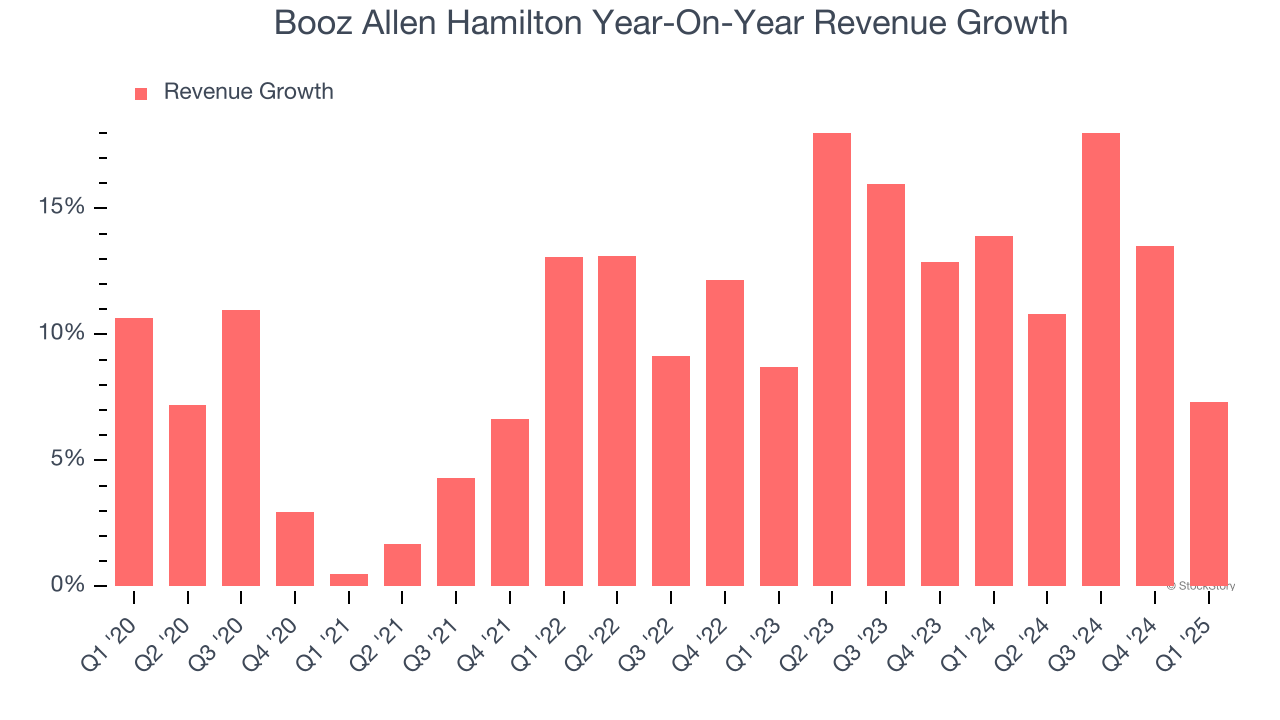
We can dig further into the company’s sales dynamics by analyzing its organic revenue, which strips out one-time events like acquisitions and currency fluctuations that don’t accurately reflect its fundamentals. Over the last two years, Booz Allen Hamilton’s organic revenue averaged 12.9% year-on-year growth. Because this number aligns with its normal revenue growth, we can see the company’s core operations (not acquisitions and divestitures) drove most of its results. 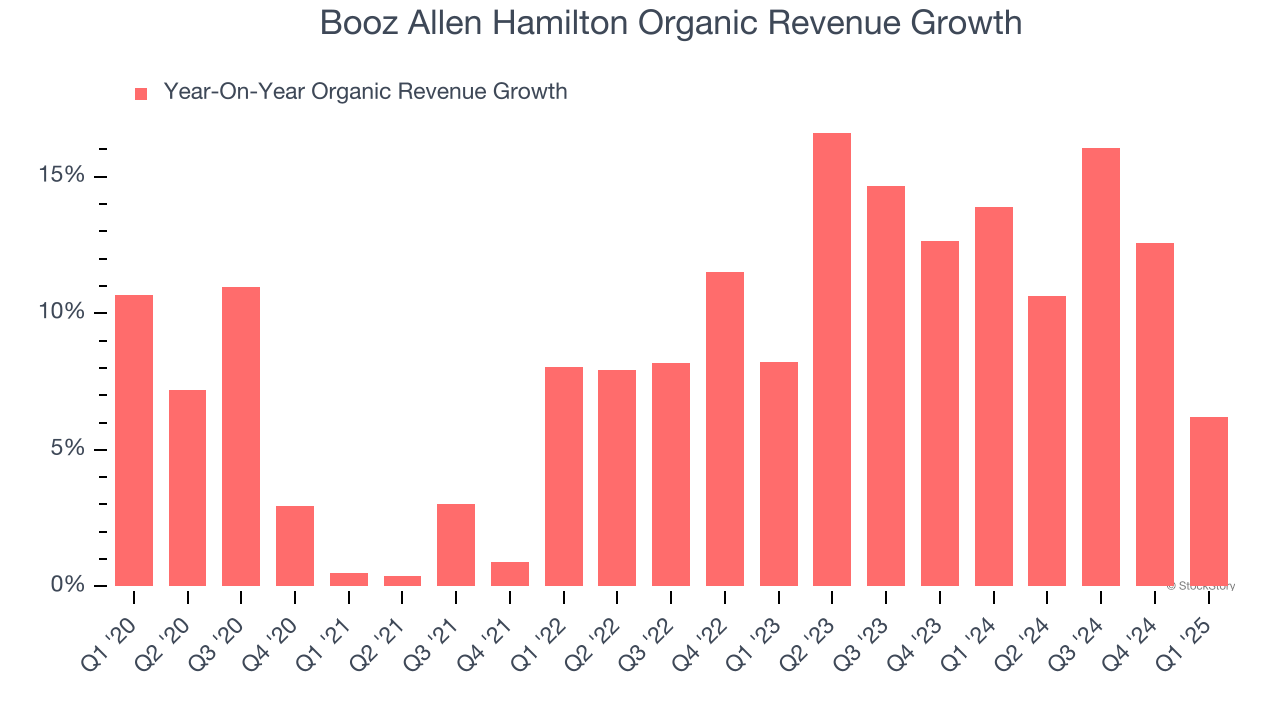
This quarter, Booz Allen Hamilton’s revenue grew by 7.3% year on year to $2.97 billion, missing Wall Street’s estimates.
Looking ahead, sell-side analysts expect revenue to grow 6.9% over the next 12 months, a deceleration versus the last two years. We still think its growth trajectory is satisfactory given its scale and implies the market sees success for its products and services.
Today’s young investors won’t have read the timeless lessons in Gorilla Game: Picking Winners In High Technology because it was written more than 20 years ago when Microsoft and Apple were first establishing their supremacy. But if we apply the same principles, then enterprise software stocks leveraging their own generative AI capabilities may well be the Gorillas of the future. So, in that spirit, we are excited to present our Special Free Report on a profitable, fast-growing enterprise software stock that is already riding the automation wave and looking to catch the generative AI next.
Operating Margin
Booz Allen Hamilton was profitable over the last five years but held back by its large cost base. Its average operating margin of 8.9% was weak for a business services business.
On the plus side, Booz Allen Hamilton’s operating margin rose by 1.8 percentage points over the last five years, as its sales growth gave it operating leverage.

This quarter, Booz Allen Hamilton generated an operating profit margin of 9.2%, in line with the same quarter last year. This indicates the company’s overall cost structure has been relatively stable.
Earnings Per Share
Revenue trends explain a company’s historical growth, but the long-term change in earnings per share (EPS) points to the profitability of that growth – for example, a company could inflate its sales through excessive spending on advertising and promotions.
Booz Allen Hamilton’s EPS grew at a spectacular 14.9% compounded annual growth rate over the last five years, higher than its 9.9% annualized revenue growth. This tells us the company became more profitable on a per-share basis as it expanded.
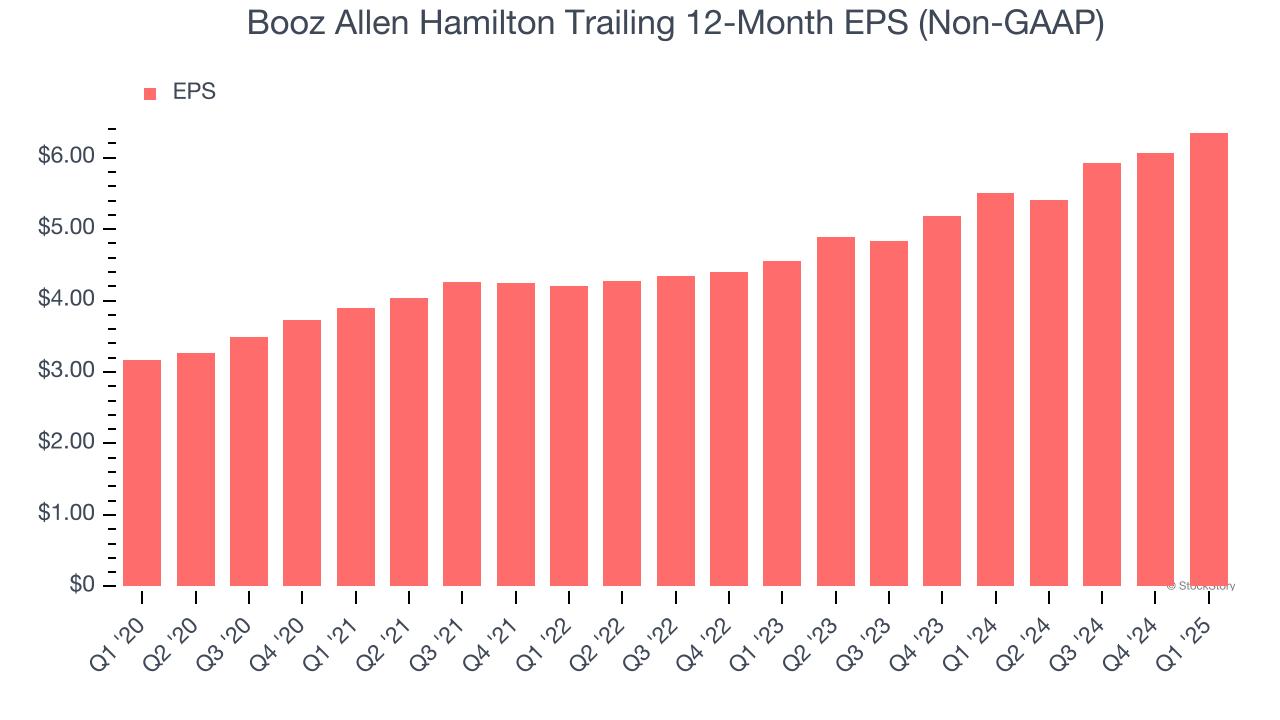
Diving into Booz Allen Hamilton’s quality of earnings can give us a better understanding of its performance. As we mentioned earlier, Booz Allen Hamilton’s operating margin was flat this quarter but expanded by 1.8 percentage points over the last five years. On top of that, its share count shrank by 10.9%. These are positive signs for shareholders because improving profitability and share buybacks turbocharge EPS growth relative to revenue growth. 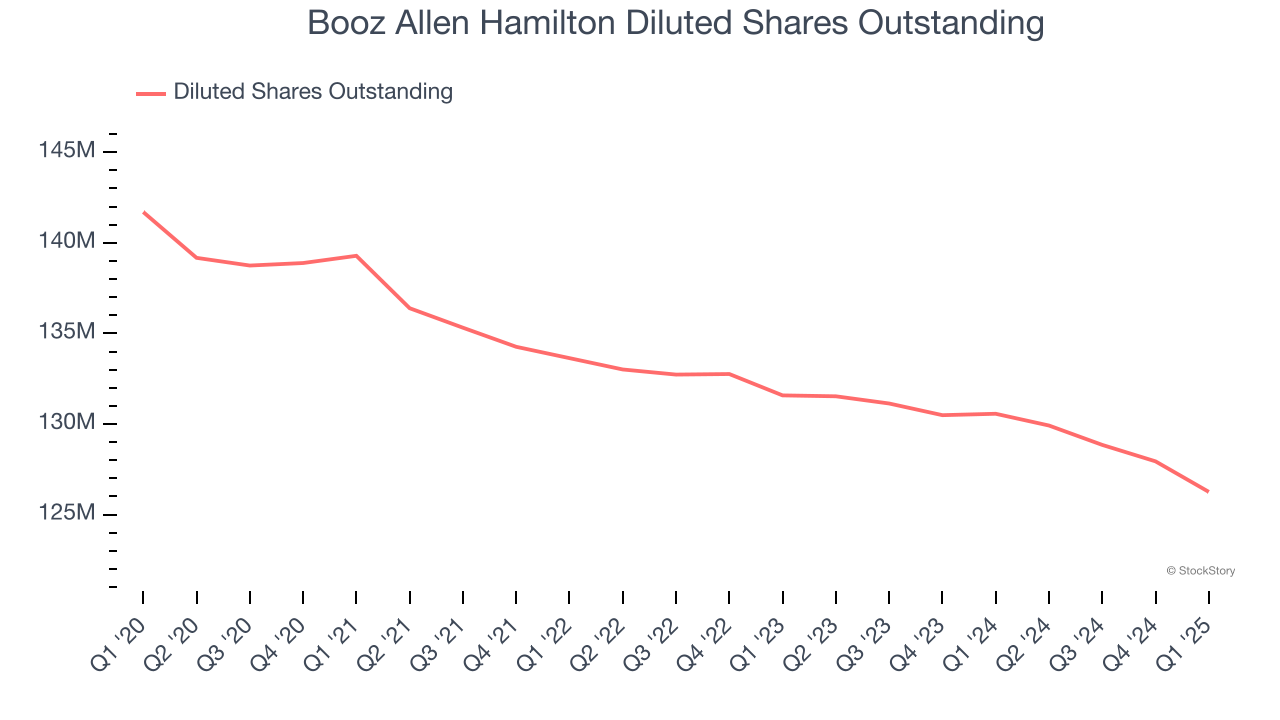
In Q1, Booz Allen Hamilton reported EPS at $1.61, up from $1.33 in the same quarter last year. This print was close to analysts’ estimates. Over the next 12 months, Wall Street expects Booz Allen Hamilton’s full-year EPS of $6.35 to grow 8.3%.
Key Takeaways from Booz Allen Hamilton’s Q1 Results
We struggled to find many positives in these results. Revenue and EBITDA both missed this quarter. Looking ahead, the company's full-year revenue guidance missed and its full-year EPS guidance fell short of Wall Street’s estimates. Overall, this quarter could have been better. The stock traded down 11% to $114.80 immediately after reporting.
Booz Allen Hamilton underperformed this quarter, but does that create an opportunity to invest right now? What happened in the latest quarter matters, but not as much as longer-term business quality and valuation, when deciding whether to invest in this stock. We cover that in our actionable full research report which you can read here, it’s free.








